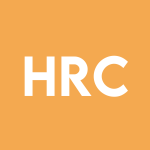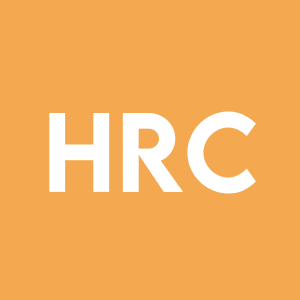Welcome to our dedicated page for Hill-Rom Hldg news (Ticker: HRC), a resource for investors and traders seeking the latest updates and insights on Hill-Rom Hldg stock.
Our selection of high-quality news articles is accompanied by an expert summary from Rhea-AI, detailing the impact and sentiment surrounding the news at the time of release, providing a deeper understanding of how each news could potentially affect Hill-Rom Hldg's stock performance. The page also features a concise end-of-day stock performance summary, highlighting the actual market reaction to each news event. The list of tags makes it easy to classify and navigate through different types of news, whether you're interested in earnings reports, stock offerings, stock splits, clinical trials, fda approvals, dividends or buybacks.
Designed with both novice traders and seasoned investors in mind, our page aims to simplify the complex world of stock market news. By combining real-time updates, Rhea-AI's analytical insights, and historical stock performance data, we provide a holistic view of Hill-Rom Hldg's position in the market.
On November 4, 2020, Hillrom (HRC) announced a first quarter dividend of $0.22 per share, payable on December 31, 2020. Shareholders on record as of December 16, 2020 will receive the dividend. This dividend indicates an annual rate of $0.88 per share, reflecting the company's commitment to returning value to shareholders amidst its operations in advancing connected care for patients globally.
Hillrom (NYSE: HRC) has announced its participation in the Stifel 2020 Virtual Healthcare Conference on November 17, 2020. CEO John Groetelaars will engage in a fireside chat at 10:00 a.m. Eastern Time, followed by virtual one-on-one meetings. The live presentation can be accessed through hillrom.com, with a replay available for 90 days post-event. Hillrom is recognized for its innovative medical technology solutions that enhance patient outcomes and healthcare efficiency, impacting over 7 million patients daily.
Hillrom (HRC) will conduct its fiscal fourth quarter 2020 earnings conference call on November 6, 2020, at 7:00 a.m. CT. Investors can participate via telephone at (844) 654-5620 or through a webcast accessible on the company's website. A recording will be available for replay until August 7, 2020. Hillrom aims to enhance patient outcomes through connected care technologies, impacting over 7 million patients daily. The call will follow the earnings announcement, providing insights into the financial performance and future outlook of the company.
Hillrom (NYSE: HRC) announced participation in the 18th Annual Morgan Stanley Global Healthcare Conference via webcast on September 14, 2020, at 12:45 p.m. Eastern Time. John Groetelaars, president and CEO, will present the company's vision and advancements in medical technology.
The event can be accessed through Hillrom's website, with a recorded replay available until November 13, 2020. Hillrom focuses on enhancing patient outcomes through connected care innovations.
Hillrom reported strong financial results for Q3 2020, with earnings of $1.40 per diluted share, up from $0.48 year-over-year. Adjusted earnings rose 59% to $1.95 per share, driven by COVID-related purchases and strategic investments. Total revenue hit $768 million, a 6% increase, with 12% core revenue growth, aided by the acquisition of Breathe Technologies. Patient Support Systems saw a 20% revenue boost, while Surgical Solutions revenue declined by 37% due to project delays. Hillrom projects at least $5.40 in adjusted earnings for fiscal 2020, emphasizing its strong market position amidst ongoing uncertainties.
Hillrom (NYSE: HRC) announced a partnership with Aiva on July 28, 2020, to enhance communication for patients and staff through voice-enabled technology. This collaboration integrates Aiva’s voice assistant with Hillrom’s Voalte® Mobile solution, allowing hands-free communication in sterile environments. The platform facilitates contact-free interactions, improving caregiver safety and patient response times. Aiva technology, enabled by Amazon Alexa, allows patients to control their environment and request assistance without physical contact. The Voalte/Aiva system is available via subscription in the U.S.
Hillrom (NYSE: HRC) announced the global launch of the PST 500 surgical table and Yellofins Apex stirrups, enhancing surgical care and patient safety. The PST 500 boasts a capacity of 1,000 pounds, modular design, and intuitive features for improved operational efficiency. The Yellofins Apex stirrups offer advanced safety with innovative locking technology, enhancing usability and infection control. Hillrom aims to elevate standards in surgical environments, reflecting their commitment to Advancing Connected Care.
Hillrom (HRC) announced a fourth quarter dividend of $0.22 per share, payable on September 30, 2020. Shareholders of record by September 18, 2020 will be eligible. This sets an annual dividend rate at $0.88 per share. Hillrom continues to focus on enhancing patient outcomes and advancing connected care through innovative medical technologies that serve over 7 million patients daily.
Hillrom (NYSE: HRC) has launched two innovative respiratory therapy devices: the Volara™ System and the Synclara™ Cough System. The Volara System provides oscillation and lung expansion therapy, proven to reduce hospital stays and time on ventilators. Clinical studies show a 31% reduction in postoperative pulmonary complications (PPC) and a significant decrease in ICU and ventilator duration. The Synclara Cough System offers non-invasive therapy to clear airways for patients with compromised lung function. Both systems are now available in the United States.
On June 16, 2020, Hillrom (NYSE: HRC) launched the Hillrom™ Extended Care Solution, a connected remote vital signs monitoring device aimed at shifting patient care closer to home. This solution combines the Welch Allyn® Spot Vital Signs® 4400 device with a patient app and clinician review portal, facilitating data-driven healthcare beyond traditional settings. Hillrom's technology is especially beneficial for recovering patients, including those with COVID-19, allowing clinicians to monitor health remotely, thus reducing hospital congestion and exposure risks.


